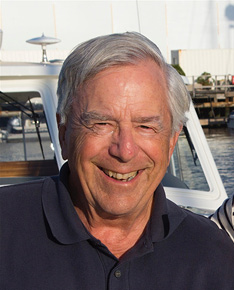
Bob Johnstone
I recently had a gam with the co founder of J Boats, the company that launched 16,000 boats beginning 1977. I listened to him spin me the history behind his dedication to performance boating. I knew that already. But how many 80-somethings write a memoir and go on the road to promote it?
He is Bob Johnstone, and he is a brand new author. His book is a memoir called Maverick Marketer: Time to Get Creative. Published April 23, 2023, the book traces his novel route to his thoroughly modern persona today.
Bob was a Quaker Oats CEO in Latin America; he founded the US Youth Sailing Championship in Chicago; he was a package goods maven who went into boat marketing at 43 to market Sunfish for a unit of a bowling company; he co-founded the 1970s upstart J Boats with brother Rod, with 50-plus designs and over 20 Boats of the Year awarded by yachting magazines; and for a sequel, he founded MJM Yachts in 2002, building it into a leader in performance powerboats. A model boat racer living in Charleston, SC with his wife, the Reverend Mary Johnstone, Bob summers in Newport. That’s a senior cat with a lot of lives.
In the event you’re unfamiliar with the entrepreneurial case history of J Boats, we did a podcast with Rod and Bob a couple years ago (conversationswithclassicboats.com). This interview is edited for length and clarity. T is Tom Darling. B is Bob Johnstone.
T: Bob, welcome to Classic Conversations, the Sailors Log.
B: Good to be here, Tom.
T: When we did a podcast with you and Rod, it was all about J Boats.
Now the new innovation is the book. How did the book come about?
B: It started nine years ago. Harry Rein told me at the 2015 Palm Beach Boat Show, “Bob, you gotta tell your story.” He repeated it in 2016. Then I talked to Michael Leavitt about doing a book in January 2017, then briefly with Roger Vaughan, but time was a problem. I was still working 14-7 running MJM Yachts.
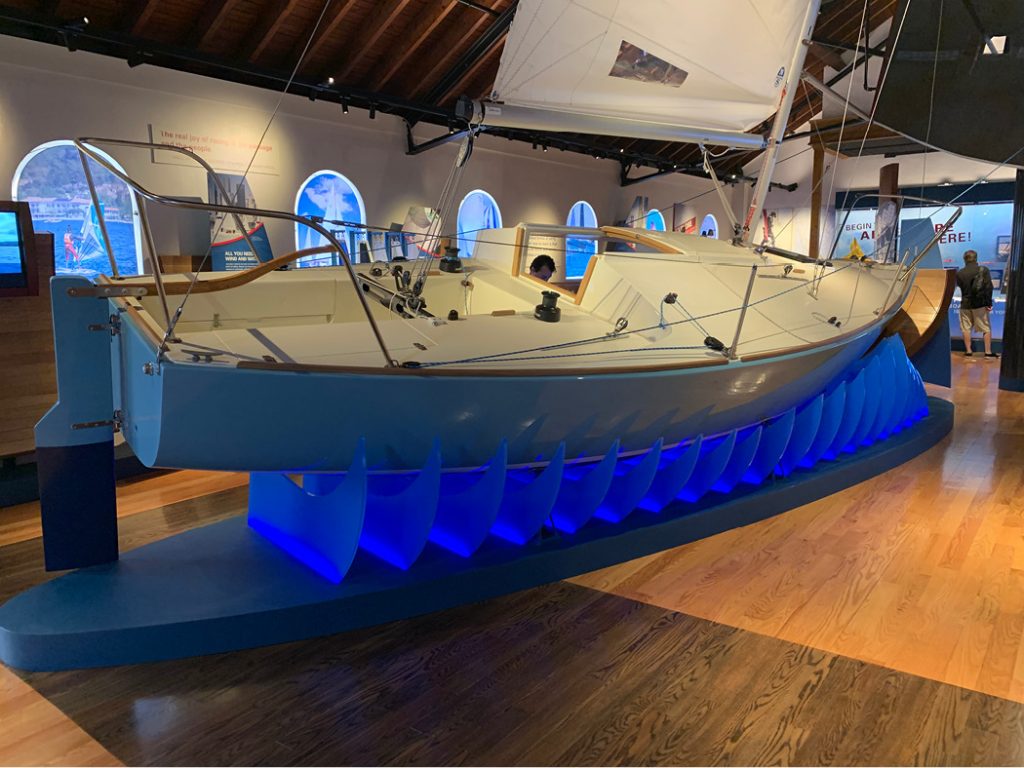
On display at The Sailing Museum in Newport, this replica of J/24 #1 Ragtime is cut away on the port side for educational purposes. The restoration needs only a couple small but critical details for the exhibit to be complete, according to the Maverick Marketer.
T: That’s a pretty heavy set of co-authors. This time you just did it on your own, right?
B: That was one of the hardest things about doing a book. Number one, getting started, then deciding whether to write it myself or have someone coauthor it, then having the time to start writing without distractions.
T: It’s a long exhausting process, but there’s so much in this book about consumer marketing. What drove you to put all of that in?
B: That was pretty much the key to the entire book. What tracks right through the book is how to come up with a new product, how do you develop the confidence that it’s going to work, and so on. I learned running Quaker subsidiaries in Colombia and Venezuela that you can’t live long enough to get good at marketing on your own. It can take three years to learn whether our new product idea is good or a bust. So, after eight years I wanted to move to product management at Quaker in Chicago. Quaker, Procter & Gamble, and General Foods were the powerhouse marketing firms at the time.
When I was put in charge of coming up with recreational product strategies, I concluded there were three possible avenues: the cheapest, the mid-range and the best performing. Best performing was the way to go because aficionados in the sport gravitate to the best. It was also more recession-proof, because if you had the best performing product you’re dealing with people who are really dedicated to the sport and the last thing they’re going to do is give it up.
When you get right down to it, beginners look to the top product or the best performing product and think, “If I get one of those I’ll be able to perform better.” The classic case was Jean Claude Killy holding up his Rossignol skis after a win.
T: You started your boat industry with the Sunfish. Who doesn’t have or know a Sunfish?
B: Well, this goes back to my demographics. My last job was director of market strategy and analysis, corporate side. That means studying demographics and market trends and verifying product ideas with consumer research.
My first job in the marine industry was VP of Marketing at AMF in 1975. They were the maker of the Sunfish. I walked into that job with a three-year plan, the center of which was a 23-foot planing sailboat to capture the 100,000 Hobie, Laser, Snark and Sunfish sailors wanting to spend more time on the water in a fast, fun to sail boat. It didn’t exist. You had Catalina 22s and O’day 25s. So, I ran consumer research in ten cities, comparing those boats to Rod’s prototype 24 [The J /24 – Ed.) and Bruce Farr’s quarter ton champion. Neither of these existed in the marketplace. The research showed 50% of respondents wanted that AMF 7.3 23-footer or the Farr quarter tonner.
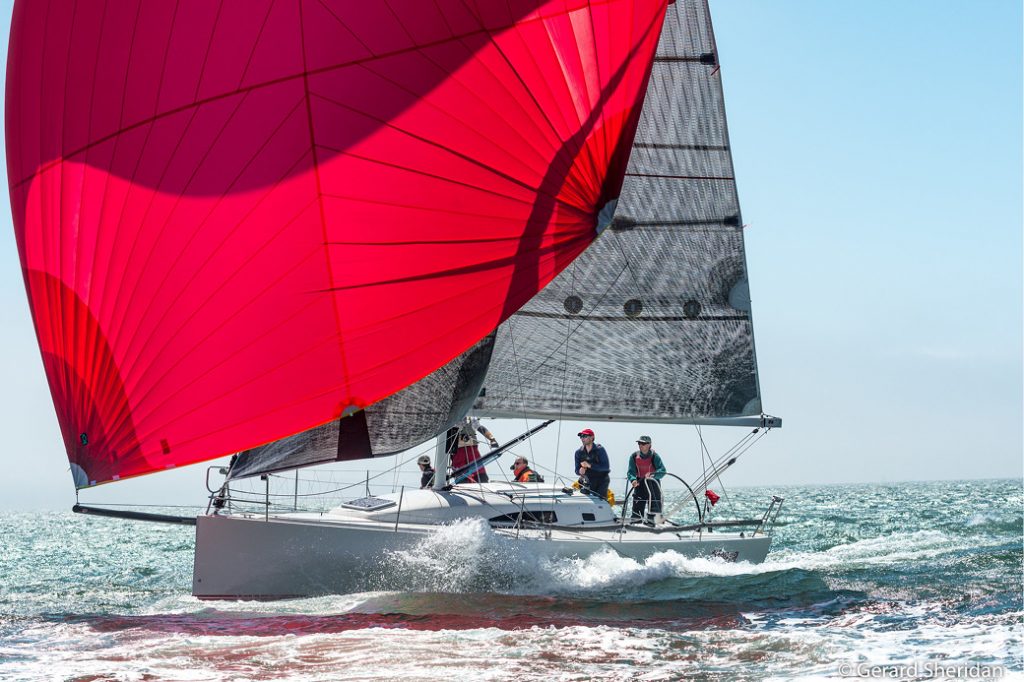
The J/111 is Bob Johnstone’s top pick for family sailing. Courtesy of J Boats
T: So, there you were!
B: That was crazy good. So, Everett [Pearson, founder of the original Pearson Yachts] asked, “OK, Bob, if I’m building this J/24, how many are we going to build, because that is going to determine the price? I said, “Well, the most anyone had sold up to now was the O’day 25 and they sold 250 in the first year. So, considering the research and Rod’s fast boat, that seemed like a reasonable target. We went with 250 the first year but ended up selling 750.
T: How many J/24s have been built?
B: Just under 6,000.
T: And built all over the world. It is really a world boat.
B: Right, we have or have had licensed builders in the UK, France, Italy, South Africa, Australia, Japan, Argentina, Brazil and the West Coast of the U.S.
T: In that podcast there was a question of how one worked with one’s family in a business like this and what the challenges were. Working with your brother and subsequently working with a lot of Johnstones was kind of a family business.
B: It was. The good part was we were all accomplished sailors and sailboat racers, so there was general agreement on what would be a good boat to create next. Now, having the third generation involved in both J Boats and MJM Yachts is an indescribable joy.
But it would be disingenuous for me to say it was all smooth sailing. J Boats was being run from three separate locations, with Rod in his home in Stonington on design, Pearson in Warren, Rhode Island building the boat and doing the engineering, and me with two or three others in Newport running the business and doing the marketing. It was hard sometimes for Rod, for instance, to share in the camaraderie of success we had going on in Newport.
T: What has been your favorite J Boat?
B: Boy, that’s a tough question. Which of the fifty is my favorite? My standard answer used to be, “The one I’m sailing now…that’s why it exists.” As for impact on the sport, I have to say the J/105 in 1991. It was the first boat over 20 feet in the world with a retractable bowsprit and asymmetric spinnaker. Now there’s hardly a new design without those. We caused the end of the parachute spinnaker.
For beauty, I think it’s the J/100. For couples cruising, the J/42 which had the stability of a carbon rig and a low CG keel. It has the stability of a 50-footer, but handles easily like a 35-footer. For couples cruising, it was the perfect boat. And for all around family sailing, I think my favorite is the J/111. It was easy to sail, small jib and asymmetric spinnaker, decent accommodations below and a nice cockpit. It was an easy boat to like. Mary and I used to go out and race that boat Wednesday nights in Newport with just the two of us.
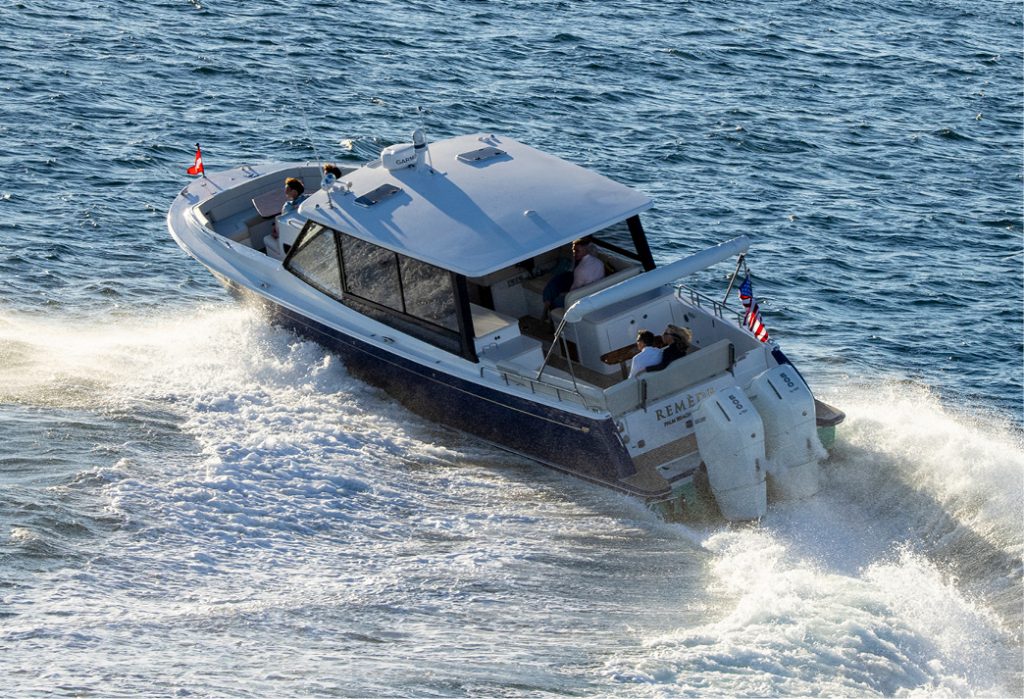
The MJM 4 was named “Best New Powerboat 30-feet and Over” at the 2022 Newport International Boat Show. Courtesy of MJM Yachts
T: I love the wheel on a J/111.
B: The greatest thing about a wheel is you can stand up going downwind and the boom is all in front of you, so you don’t have to worry about ducking the boom when you’re jibing. It’s a lot safer and you feel more in control.
T: There’s been tremendous change from the baby boomers to today’s millennials…
B: It’s hard to say, but one factor was the pandemic which required social distancing, staying out of crowds, and so on. That was a tremendous boost to boating. Most manufacturers were backlogged by a year or more. People figured, “Well OK, it’s safe being a family unit out on the water, sailing or powerboating.”
A lot of people got exposed to the sport and kids got dragged along that might not have gone otherwise, and I’m not sure it’s all racing. Certainly one of the trends we think is important is dayboating, and that’s one of the reasons we came out with the long cockpit design.
T: Like the J/9…
B: Right.
T: I finally got to The Sailing Museum in Newport. I walked in and saw a boat I first saw in 1977, Ragtime, sawed in half. How did that come about?
B: That was a fun project. I think one of the exhibit designers came up with the thought of a boat with a cutaway showing the inside and so forth. That would be a unique exhibit and Son Stuart pulled it off, finding a used J/24 for George Borges to cut up, refinish and then install. In fact, the original Ragtime was totally cut up because Everett used it as a plug for his molds.
The one thing missing on that exhibit is the cooler step we used to have on the J/24. It was an Igloo cooler with a piece of teak on it. That and a six pack of beer would make it completely legit!
T: How did MJM come about?
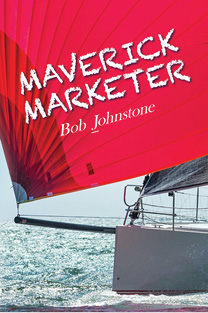
In his new memoir, the world class sailor and marketing guru shares lessons learned from boating to boardrooms.
B: Well, I guess it’s demographics again. I was 68 years old and Mary and I were spending more time cruising and using our Dyer 29 than our 40-foot J 120. Sailing was becoming me racing with the guys and leaving Mary to spectate. I’d always enjoyed sailing and cruising with Mary and the Dyer wasn’t an ideal answer. For a cruising boat it was a little small, and not fast enough to ride ahead of the waves. If we were going to be spending more time in a powerboat, why not do the same thing we did with J Boats: define our ideal boat and see if it exists.
There were Hinckleys that were pretty boats but not very functional. There were a lot of lobster yachts that were functional but slow. We concluded that our ideal boat didn’t exist, so we’d have to create it. We came up with 25 things we’d like for our new powerboat. We had an idea of what we wanted it to look like, so we got a designer to draw it and make sure it floated on its lines.
T: Why do I think you used outboards a lot?
B: We started out with a single diesel and eventually got up to a model that had triple diesels that would go 50 mph. I wanted to have J Boats-like performance, to be the leading performance brand in powerboats.
You can make a barn door go 50 mph by tacking six outboards on it. Powerboat design is not particularly sophisticated. With a sailboat, you have a finite energy source in the wind and you have to be good on design to create a better sailboat in terms of shape and rig design.
For powerboats, we decided on the amount of speed you can get out of a given horsepower, the most to get to 25 knots, which we wanted. That meant picking up on the technology of a fast sailboat: an advanced carbon epoxy composite boat Nobody in the powerboat businesses was making this in a production setting.
T: So, we’re talking about the equivalent of a J/125 or 145…
B: Yeah, and that led me to Mark Lindsay who had been making world championship and Olympic winning and America’s Cup hulls.
T: Did the hulls come out lighter?
B: Yeah, sure. The original 34Z came out at around 11,000 pounds. There were sportfishermen at 34 feet that were twice that. Our opening line was, “Twice the fun, half the fuel.” And we achieved that burning half the fuel at 25 knots.
But it was a hard sell then. We were two years in before we sold five boats. You asked what surprised me about powerboat owners versus sailboat owners.
One of them is networking. Sixty-five per cent of J owners read Sailing World. I could tell a sailmaker that we were coming up with a new 46-foot sailboat, and in a week the whole world would know.
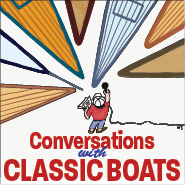
Click here to tune into Tom Darling’s Conversations with Classic boats podcast.
T: Now we come to the part of the conversation where we ask everyone the same thing. What’s your favorite boat, and your favorite sailing water?
B: How much time do we have? OK, for family sailing, the J/111. And Charleston Harbor and the Downeast islands of Maine.
T: Thanks for participating Bob, and good luck with the book. It looks great! ■




